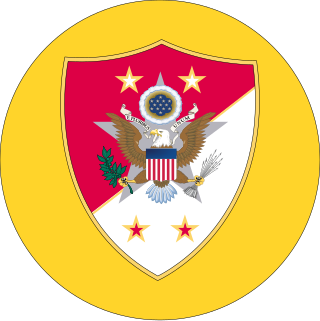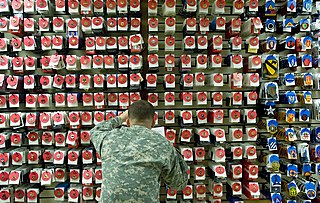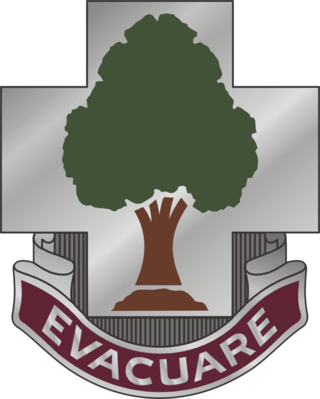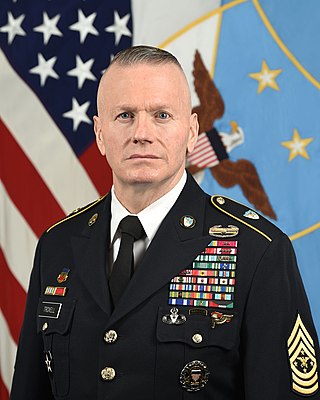
In military organizations, a colour guard is a detachment of soldiers assigned to the protection of regimental colours and the national flag. This duty is highly prestigious, and the military colour is generally carried by a young officer (ensign), while experienced non-commissioned officers are assigned to the protection of the national flag. These non-commissioned officers, accompanied in several countries by warrant officers, can be ceremonially armed with either sabres or rifles to protect the colour. Colour guards are generally dismounted, but there are also mounted colour guard formations as well.

A non-commissioned officer (NCO) is a military officer who does not hold a commission. Non-commissioned officers usually earn their position of authority by promotion through the enlisted ranks. In contrast, commissioned officers usually enter directly from a military academy, officer training corps (OTC) or reserve officer training corps (ROTC), or officer candidate school (OCS) or officer training school (OTS), after receiving a post-secondary degree.
Sergeant major is a senior non-commissioned rank or appointment in many militaries around the world.
The chart below represents the current enlisted rank insignia of the United States Air Force.
The chart below shows the current enlisted rank insignia of the United States Army, with seniority, and pay grade, increasing from right to left. The enlisted ranks of corporal (E-4) and higher are considered non-commissioned officers (NCOs). The rank of specialist is also in pay grade E-4, but does not hold non-commissioned officer status; it is common that a soldier may never hold the rank of corporal, and instead be promoted from specialist to sergeant, attaining junior NCO status at that time.

A chief master sergeant is the military rank for a senior non-commissioned officer in the armed forces of some countries.

The sergeant major of the Army (SMA) is a unique non-commissioned rank and position of office in the United States Army. The holder of this rank and position is the most senior enlisted soldier in the Army, unless an enlisted soldier is serving as the senior enlisted advisor to the chairman. The SMA is appointed to serve as a spokesman to address the issues of enlisted soldiers to all officers, from warrant officers and lieutenants to the Army's highest positions. As such, they are the senior enlisted advisor to the chief of staff of the Army. The exact duties vary depending on the chief of staff, though much of the SMA's time is spent traveling throughout the Army, observing training and talking with soldiers and their families.

Kenneth O. Preston is a retired United States Army soldier who served as the Sergeant Major of the Army. He was sworn in as the 13th Sergeant Major of the Army on January 15, 2004. Preston served 7 years and 2 months as Sergeant Major of the Army making him the longest serving Sergeant Major of the Army to date.

A distinctive unit insignia (DUI) is a metallic heraldic badge or device worn by soldiers in the United States Army. The DUI design is derived from the coat of arms authorized for a unit. DUIs may also be called "distinctive insignia" (DI) or, imprecisely, a "crest" or a "unit crest" by soldiers or collectors. The U.S. Army Institute of Heraldry is responsible for the design, development and authorization of all DUIs.
In the United States Army, Marine Corps, Air Force and Space Force, major is a field officer above the rank of captain and below the rank of lieutenant colonel. It is equivalent to the naval rank of lieutenant commander in the other uniformed services. Although lieutenant commanders are considered junior officers by their services, the rank of major is that of a senior officer in the United States Army, the United States Marine Corps, and the United States Air Force.

The Oklahoma National Guard, a division of the Oklahoma Military Department, is the component of the United States National Guard in the U.S. state of Oklahoma. It comprises both Army (OKARNG) and Air (OKANG) National Guard components. The Governor of Oklahoma is Commander-in-Chief of the Oklahoma National Guard when not on federal active duty. The state's highest-ranking military commander, the Adjutant General of Oklahoma (TAG), serves as the military head of the Guard and is second only to the Governor. The TAG is served by Assistant Adjutants General, all brigadier generals, from the OKARNG and OKANG. The two components each have a senior noncommissioned officer, State Command Sergeant Major for Army and State Command Chief Master Sergeant for Air. The TAG is also served by his Director of the Joint Staff or Chief of Staff, who has direct oversight of the state's full-time National Guard military personnel and civilian employees.

In the United States Army, soldiers may wear insignia to denote membership in a particular area of military specialism and series of functional areas. Army branch insignia is similar to the line officer and staff corps officer devices of the U.S. Navy as well as to the Navy enlisted rating badges. The Medical, Nurse, Dental, Veterinary, Medical Service, Medical Specialist, Chaplains, and Judge Advocate General's Corps are considered "special branches", while the others are "basic branches".

In the United States Armed Forces, the ranks of warrant officer are rated as officers above all non-commissioned officers, candidates, cadets, and midshipmen, but subordinate to the lowest officer grade of O‑1. This application differs from the Commonwealth of Nations and other militaries, where warrant officers are the most senior of the other ranks, equivalent to the U.S. Armed Forces grades of E‑8 and E‑9.

The senior enlisted advisor to the chairman of the Joint Chiefs of Staff (SEAC) is the most senior non-commissioned officer (NCO) position overall in the United States Armed Forces. The SEAC is appointed by the chairman of the Joint Chiefs of Staff to serve as a spokesperson to address the issues of enlisted personnel to the highest positions in the Department of Defense. As such, the SEAC is the primary enlisted advisor to the chairman, and serves at the pleasure of the secretary of defense. The SEAC's exact duties vary, depending on the chairman, though the SEAC generally devotes much of their time traveling throughout the Department of Defense, to observe training and communicating to service members and their families. The SEAC's normal term of assignment runs concurrently with the chairman, but an incumbent may be reappointed to serve longer. The first member to hold this post was William Gainey. The current SEAC is Troy E. Black, USMC who assumed the duties on 3 November 2023.

The 115th Field Hospital is a field hospital of the United States Army formed in 1917 and perpetuated until today. The hospital has participated in World War I, World War II, Desert Storm, Operation Iraqi Freedom and Operation Enduring Freedom (Afghanistan). As of March 2019, the 115th Combat Support Hospital reorganized and re-designated as a field hospital and is now a component unit of the 32d Hospital Center.
First sergeant is typically a senior non-commissioned officer rank, used in many countries.

John Wayne Troxell is a retired United States Army senior non-commissioned officer who served as the third Senior Enlisted Advisor to the Chairman of the Joint Chiefs of Staff (SEAC). This position made him the most senior enlisted member of the United States Armed Forces. He enlisted in the United States Army in September 1982, as an armored reconnaissance specialist and graduated from One Station Unit Training at Fort Knox, Kentucky.

Raquel DiDomenico (Steckman) was the first female combat engineer senior sergeant in the United States Army appointed to a sapper company as a first sergeant.

















